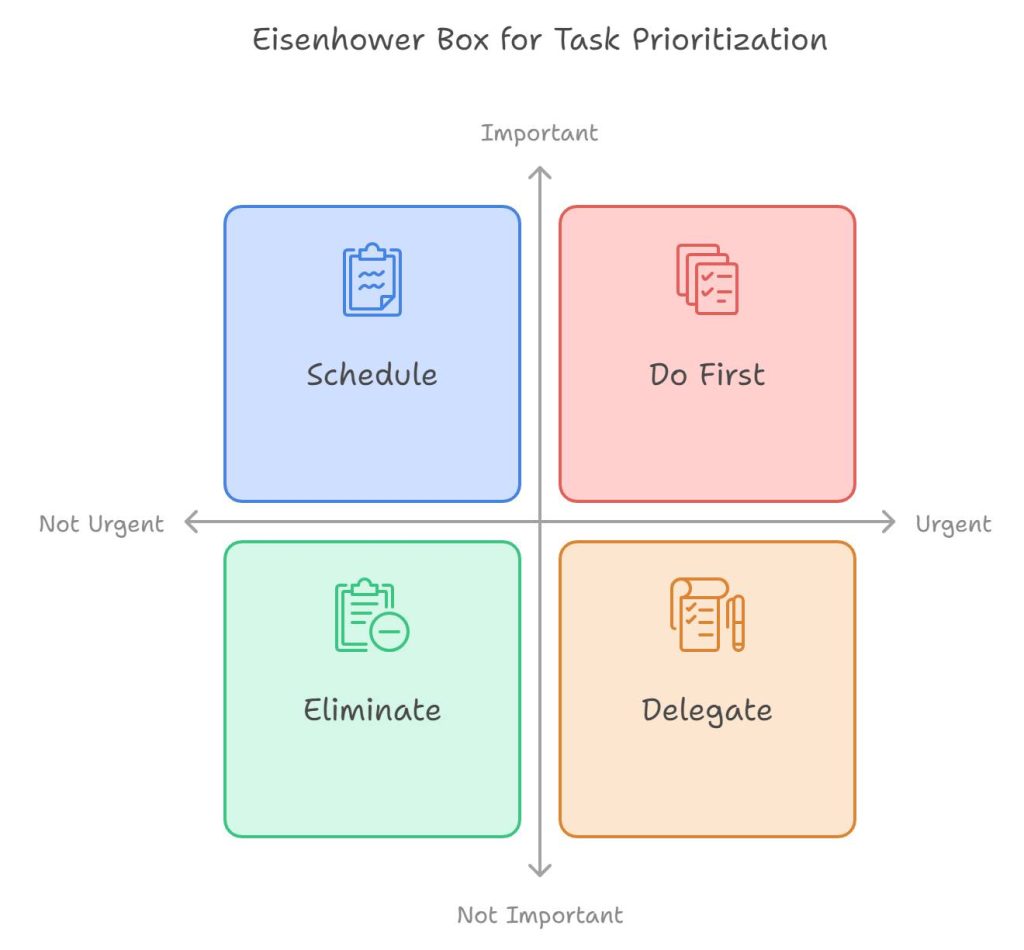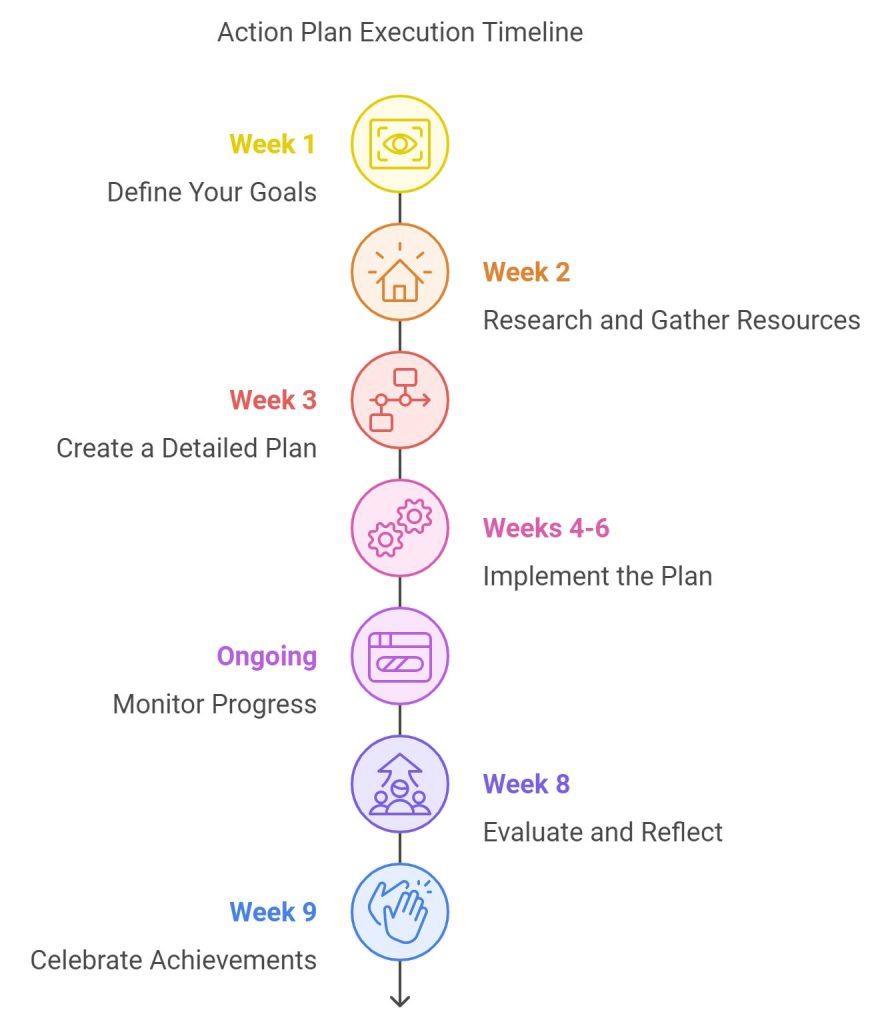Goal setting is a fundamental aspect of professional development that serves as a roadmap for career advancement. By establishing clear objectives, individuals can focus their efforts, prioritize tasks, and measure their progress over time.
Goals provide direction, enhance motivation, and foster a sense of purpose, which are essential components for achieving long-term career success. Without defined goals, professionals may find themselves drifting without a clear path, leading to stagnation and diminished job satisfaction.
Numerous studies underscore the positive impact of goal setting on professional outcomes. For instance:
- Locke and Latham’s Goal Setting Theory: Research by Edwin Locke and Gary Latham has consistently shown that specific and challenging goals lead to higher performance levels compared to vague or easy goals. Their studies indicate that goal setting can increase productivity by up to 25%.
- Harvard Business Review: An article published in HBR found that employees who set goals are 10 times more likely to achieve them than those who do not. Additionally, organizations that implement structured goal-setting practices report higher levels of employee engagement and retention.
- Gallup Research: Gallup’s research reveals that professionals who regularly set and review their goals are more likely to experience career growth and job satisfaction. They also demonstrate greater resilience and adaptability in the face of challenges.
These statistics highlight that goal setting is not merely a theoretical concept but a practical tool that can lead to tangible improvements in career trajectories.
This article serves as a comprehensive guide to mastering professional goal setting. Readers will be walked through a structured, step-by-step process that begins with defining a clear professional vision and culminates in actionable plans to achieve their career aspirations. Each step is designed to help professionals set meaningful, attainable goals that align with their personal values and long-term objectives.
Importance of a Structured, Step-by-Step Approach
A structured approach to goal setting ensures that objectives are well-defined and achievable. By following a step-by-step methodology, professionals can systematically address each aspect of their career planning, from initial vision crafting to ongoing progress monitoring. This method reduces the overwhelm that often accompanies ambitious career planning and provides a clear framework for sustained growth and success.
Moreover, a systematic approach facilitates adaptability, allowing individuals to adjust their goals in response to changing circumstances and new opportunities.
Step 1: Define Your Professional Vision
Understanding Your Long-Term Career Aspirations
Reflecting on Where You Want to Be in 5, 10, 20 Years
Defining a professional vision begins with introspection about your long-term career aspirations. Consider where you see yourself in the next 5, 10, or even 20 years. Ask yourself questions such as:
- What positions or roles do I aspire to hold?
- What industries or sectors am I passionate about?
- What skills and expertise do I want to develop?
- What impact do I want to make in my field?
Visualizing your future helps create a clear picture of your desired career path. This vision serves as the foundation upon which all your professional goals will be built, ensuring that each objective aligns with your ultimate aspirations.
Aligning Goals with Personal Values and Passions
Ensuring Goals Resonate with Your Core Values
For goals to be meaningful and motivating, they must align with your personal values and passions. Reflect on what truly matters to you in your professional life. Consider values such as:
- Integrity and ethical standards
- Work-life balance
- Continuous learning and growth
- Innovation and creativity
- Collaboration and teamwork
When your goals resonate with these core values, you’re more likely to stay committed and enthusiastic about pursuing them. This alignment ensures that your career path is not only successful but also fulfilling and authentic to who you are.
Creating a Vision Statement
How to Craft a Clear and Motivating Vision Statement
A vision statement is a concise declaration of your long-term professional aspirations. It serves as a guiding star, providing clarity and direction as you set and pursue your goals. To craft an effective vision statement, follow these steps:
- Reflect on Your Aspirations: Revisit your long-term career aspirations and the values that are important to you.
- Be Specific and Clear: Avoid vague language. Clearly articulate what you aim to achieve and the impact you wish to make.
- Incorporate Your Values: Ensure that your vision statement reflects your core values and passions.
- Keep It Concise: A vision statement should be brief and memorable, typically one to two sentences.
- Make It Inspiring: Use positive and motivating language that energizes you to take action.
Example of a Vision Statement:
“To become a leading expert in sustainable engineering, driving innovative solutions that reduce environmental impact and promote renewable energy adoption worldwide.”
By creating a clear and motivating vision statement, you establish a strong foundation for your professional goal-setting journey. This statement will not only guide your goal selection but also serve as a constant reminder of your ultimate career objectives.
Step 2: Set SMART Goals
Setting SMART goals ensures that your objectives are clear, attainable, and aligned with your professional vision. SMART is an acronym that stands for Specific, Measurable, Achievable, Relevant, and Time-bound. Each component plays a crucial role in effective goal setting.

Specific
Defining Clear and Precise Objectives
A specific goal is well-defined and unambiguous, providing a clear direction for your efforts. To make your goals specific, consider the following questions:
- What exactly do I want to achieve?
- Why is this goal important?
- Who is involved or affected?
- Where will this goal be accomplished?
- Which resources or constraints are relevant?
Example:
Instead of setting a vague goal like “Improve my professional skills,” a specific goal would be “Complete a certification in project management within the next six months to enhance my ability to lead complex projects.”
“A goal properly set is halfway reached.”
— Zig Ziglar
B. Measurable
Establishing Criteria to Track Progress
Measurable goals allow you to track your progress and stay motivated. They include concrete criteria that can be quantified or qualified. To make your goals measurable, ask yourself:
- How much?
- How many?
- How will I know when it is accomplished?
Example:
“Increase my sales by 15% in the next quarter by expanding my client base and enhancing my sales techniques.”
Achievable
Setting Realistic and Attainable Goals
Achievable goals are realistic and consider your current skills, resources, and constraints. While it’s important to challenge yourself, setting unattainable goals can lead to frustration and demotivation. To ensure your goals are achievable, evaluate:
- Do I have the necessary resources and skills?
- Is the goal within my control?
- Can I achieve this goal with the time and resources available?
Example:
“Attend two professional development workshops and apply the learned skills to lead a successful project within the next year.”
Relevant
Ensuring Goals Are Aligned with Your Vision and Career Path
Relevant goals align with your long-term professional vision and are pertinent to your career growth. They should resonate with your values and aspirations. To assess relevance, consider:
- Does this goal align with my career objectives?
- Is this the right time to pursue this goal?
- Does achieving this goal help me move forward in my career?
Example:
“Pursue a leadership role within my department to gain management experience and prepare for future executive positions.”
Time-bound
Setting Deadlines to Create Urgency and Focus
Time-bound goals have a clear deadline, which helps maintain focus and urgency. Deadlines prevent procrastination and provide a timeline for achieving your objectives. To make your goals time-bound, specify:
- When will I achieve this goal?
- What can I do today, six months from now, and one year from now?
Example:
“Launch a new marketing campaign within the next three months to increase brand awareness and attract new customers.”
Step 3: Prioritize Your Goals
Once you have set your SMART goals, the next step is to prioritize them. Prioritization ensures that you focus on the most important and impactful goals, effectively managing your time and resources.

Identifying High-Impact Goals
Determining Which Goals Will Have the Most Significant Effect on Your Career
Not all goals carry the same weight in terms of their impact on your professional development. High-impact goals are those that significantly contribute to your long-term vision and career advancement. To identify high-impact goals, consider:
- Which goals align most closely with my professional vision?
- Which goals offer the greatest return on investment in terms of time and resources?
- Which goals will enhance my skills and qualifications the most?
Example:
“Obtaining a leadership certification may have a higher impact on advancing to managerial roles compared to attending a single networking event.”
“The key is not to prioritize what’s on your schedule, but to schedule your priorities.”
— Stephen Covey
Balancing Short-Term and Long-Term Goals
Strategies for Managing Immediate Tasks While Keeping an Eye on Future Aspirations
Balancing short-term and long-term goals is essential for sustained career growth. Short-term goals provide immediate focus and achievements, while long-term goals ensure you are progressing toward your ultimate vision. Strategies for balancing include:
- Integrate short-term goals that serve as stepping stones to long-term objectives.
- Allocate time and resources proportionately between immediate tasks and future planning.
- Regularly review and adjust goals to maintain alignment and balance.
Example:
“Short-term goal: Complete a course in data analysis within three months.
Long-term goal: Transition into a data-driven decision-making role within the next two years.”
Creating a Priority Matrix
Tools and Techniques for Prioritizing Effectively
A priority matrix helps categorize goals based on their urgency and importance, facilitating effective decision-making. One commonly used tool is the Eisenhower Matrix, which divides tasks into four quadrants:
- Urgent and Important: Tasks that require immediate attention.
- Important but Not Urgent: Tasks that are crucial for long-term success but do not require immediate action.
- Urgent but Not Important: Tasks that need to be done soon but are not significant in the long run.
- Not Urgent and Not Important: Tasks that have minimal impact and can be delegated or eliminated.
How to Use a Priority Matrix:
- List all your goals and tasks.
- Assign each to a quadrant based on urgency and importance.
- Focus primarily on tasks in the “Urgent and Important” and “Important but Not Urgent” quadrants.
- Delegate or defer tasks in the other quadrants as appropriate.
Example:
A goal to “Complete an advanced certification” might fall into the “Important but Not Urgent” quadrant, while “Responding to non-critical emails” might be placed in the “Urgent but Not Important” quadrant.
Step 4: Develop an Action Plan
An action plan outlines the specific steps you need to take to achieve your goals. It transforms abstract objectives into concrete actions, making your goals more attainable.

Breaking Down Goals into Manageable Tasks
Creating Actionable Steps for Each Goal
Breaking down each goal into smaller, manageable tasks makes the overall objective less daunting and easier to accomplish. This approach helps maintain momentum and provides clear direction. To break down goals:
- Identify the key components required to achieve the goal.
- Divide each component into specific tasks or actions.
- Assign deadlines and responsibilities for each task.
Example:
For the goal “Launch a new marketing campaign within three months”:
- Research target audience and market trends (Week 1-2).
- Develop campaign strategy and objectives (Week 3-4).
- Create marketing materials and content (Week 5-6).
- Implement the campaign across chosen platforms (Week 7-12).
- Monitor and analyze campaign performance (Ongoing).
Allocating Resources and Responsibilities
Identifying What Resources (Time, Money, Skills) Are Needed
Effective resource allocation ensures that you have everything necessary to execute your action plan successfully. This involves identifying the resources required and assigning responsibilities appropriately.
- Time: Determine how much time each task will take and schedule accordingly.
- Money: Budget for any financial resources needed, such as training programs or tools.
- Skills: Assess whether you have the necessary skills or if additional training is required.
- Support: Identify any support or assistance needed from colleagues, mentors, or external partners.
Example:
For the goal “Complete a certification in project management”:
- Time: Allocate 5 hours per week for study and coursework.
- Money: Budget $1,200 for course fees and materials.
- Skills: Identify areas where additional knowledge is needed and seek supplementary resources.
- Support: Enroll in a study group or seek guidance from a mentor.
Setting Milestones
Establishing Checkpoints to Monitor Progress
Milestones are significant points along the timeline of your goal that mark progress and provide opportunities for evaluation and adjustment. Setting milestones helps maintain motivation and ensures you stay on track.
- Define key achievements that signify progress toward your goal.
- Assign specific deadlines to each milestone.
- Celebrate the completion of milestones to reinforce positive behavior.
Example:
For the goal “Increase sales by 15% in the next quarter”:
- Month 1: Secure five new clients.
- Month 2: Launch a targeted marketing campaign.
- Month 3: Achieve a 10% increase in sales by mid-quarter and an additional 5% by the end of the quarter.
Benefits of Setting Milestones:
- Provides a sense of accomplishment as each milestone is reached.
- Allows for regular assessment and adjustment of strategies if necessary.
- Keeps the overall goal manageable by breaking it into smaller parts.
By thoroughly developing these steps, you equip yourself with a clear and actionable roadmap to achieve your professional goals. Each step builds upon the previous one, ensuring a cohesive and strategic approach to career development.
Step 5: Set Deadlines and Milestones
Setting deadlines and milestones is crucial for maintaining momentum and ensuring that your goals are achieved in a timely manner. This step helps create a sense of urgency and provides clear checkpoints to assess your progress.
Establishing Realistic Timelines
How to Set Achievable Deadlines
Setting realistic deadlines ensures that your goals are attainable without causing undue stress or burnout. To establish achievable timelines, consider the following:
- Assess Your Current Workload: Evaluate your existing commitments to determine how much time you can realistically allocate to your new goals.
- Break Down Tasks: Divide larger tasks into smaller, more manageable segments, each with its own deadline.
- Consider External Factors: Take into account any external dependencies, such as project timelines, team availability, or market conditions.
- Be Flexible: Allow buffer time for unexpected challenges or delays to avoid feeling overwhelmed.
- Set Priorities: Determine which tasks are most critical and allocate your time accordingly.
Example:
If your goal is to “Complete a certification in digital marketing,” set a realistic timeline by breaking it down:
- Research Certification Programs (Week 1-2)
- Enroll in the Program (Week 3)
- Complete Coursework (Weeks 4-12)
- Pass Certification Exam (Week 13)
- Apply New Skills in a Project (Weeks 14-16)
Creating a Timeline or Calendar
Tools for Scheduling and Tracking Deadlines
Utilizing timelines and calendars helps visualize your goals and ensures that you stay on track. Here are some effective tools and techniques:
- Gantt Charts: Visualize the start and end dates of each task, showing dependencies and overlaps.
- Digital Calendars: Tools like Google Calendar, Microsoft Outlook, or Apple Calendar can help schedule deadlines and set reminders.
- Project Management Software: Platforms such as Asana, Trello, or Monday.com offer comprehensive features for tracking tasks, deadlines, and progress.
- Printable Planners: For those who prefer physical copies, printable planners or bullet journals can be customized to fit your needs.
- Timeline Templates: Use pre-designed templates available in software like Microsoft Excel or PowerPoint to create detailed timelines.
Example:
Using Trello, you can create boards for each goal, add lists for different stages (To Do, In Progress, Completed), and set due dates for each task. This visual representation makes it easy to monitor progress and adjust timelines as needed.
Celebrating Milestone Achievements
Importance of Recognizing and Rewarding Progress
Celebrating milestones is essential for maintaining motivation and reinforcing positive behavior. Recognizing achievements, no matter how small, provides a sense of accomplishment and encourages continued effort.
- Boosts Morale: Celebrations can enhance your enthusiasm and commitment to your goals.
- Provides Motivation: Acknowledging progress keeps you motivated to tackle subsequent tasks.
- Reinforces Positive Habits: Rewarding yourself for reaching milestones helps establish productive routines.
- Encourages Reflection: Celebrations offer opportunities to reflect on what worked well and what can be improved.
Example:
After completing the first module of your digital marketing certification, reward yourself with a favorite meal, a short break, or a small purchase. This acknowledgment reinforces your progress and keeps you motivated for the next steps.
Step 6: Monitor and Track Progress
Monitoring and tracking your progress ensures that you remain aligned with your goals and can make necessary adjustments along the way. This step involves regular assessments and utilizing tools to stay organized.

Regularly Reviewing Goal Status
Setting Up Regular Check-ins (Weekly, Monthly)
Consistent reviews help you stay accountable and make timely adjustments. Here’s how to effectively set up check-ins:
- Weekly Reviews: Assess what you accomplished during the week, identify any obstacles, and plan tasks for the upcoming week.
- Monthly Reviews: Evaluate your progress towards larger milestones, adjust timelines if necessary, and set priorities for the next month.
- Quarterly Reviews: Take a broader look at your overall goals, celebrate major achievements, and realign your strategies with any new developments.
Example:
Schedule a weekly review session every Friday afternoon to go over the tasks you completed, address any challenges you faced, and outline your priorities for the following week. Additionally, conduct a monthly review on the last day of each month to assess your progress toward your quarterly milestones.
Using Tracking Tools and Software
Recommendations for Apps and Tools to Assist in Tracking
Leveraging technology can streamline the tracking process and provide valuable insights into your progress. Here are some recommended tools:
- Asana: A project management tool that allows you to create tasks, set deadlines, and track progress through various views (list, board, calendar).
- Trello: Utilizes boards and cards to organize tasks and monitor their status. Ideal for visual tracking.
- Todoist: A simple task manager that helps you prioritize and track daily tasks with deadlines and reminders.
- Notion: An all-in-one workspace where you can create databases, calendars, and to-do lists to track your goals.
- Microsoft Excel or Google Sheets: Customizable spreadsheets for detailed tracking and data analysis.
- Habitica: Turns goal tracking into a game, providing rewards and accountability through a gamified system.
Example:
Use Notion to create a comprehensive dashboard that includes your goals, tasks, deadlines, and progress charts. This centralized system allows you to easily update and monitor all aspects of your goal-setting process.
Adjusting Strategies as Needed
Being Flexible and Making Necessary Adjustments Based on Progress
Flexibility is key to successful goal achievement. As you monitor your progress, you may encounter unexpected challenges or opportunities that require you to adjust your strategies.
- Identify Obstacles: Recognize any barriers that are hindering your progress and develop solutions to overcome them.
- Reassess Priorities: Sometimes priorities shift due to changing circumstances. Reevaluate your goals to ensure they remain relevant.
- Modify Action Plans: Adjust your tasks and timelines based on your current situation and progress.
- Seek Feedback: Engage with mentors, peers, or supervisors to gain insights and suggestions for improvement.
- Stay Resilient: Maintain a positive attitude and be willing to pivot when necessary to stay on track toward your goals.
Example:
If you find that balancing work and study for your certification is challenging, consider adjusting your study schedule, seeking support from colleagues, or extending the timeline to ensure you can maintain both commitments effectively.
Step 7: Adjust and Reevaluate Goals
As your career progresses and circumstances change, it’s essential to periodically adjust and reevaluate your goals to ensure they remain aligned with your evolving aspirations and external environment.
Recognizing When to Pivot
Signs That a Goal Needs to Be Adjusted or Changed
Not all goals remain relevant or achievable over time. Recognizing when to pivot helps you stay adaptable and focused on what truly matters.
- Lack of Progress: If you consistently fail to make progress despite sustained effort, it may indicate that the goal is unrealistic or misaligned.
- Changing Priorities: Shifts in personal or professional priorities can render certain goals less important.
- New Opportunities: Emerging opportunities may necessitate a change in focus or the adoption of new goals.
- External Changes: Economic shifts, industry trends, or organizational changes can impact the feasibility or relevance of your goals.
- Loss of Motivation: If you no longer feel motivated or passionate about a goal, it might be time to reassess its importance.
Example:
If your goal was to “Become a senior manager within two years,” but your company undergoes a major restructuring, it might be necessary to adjust your timeline or redefine what advancement means in the new organizational context.
Incorporating Feedback and Lessons Learned
Using Experiences to Refine Goals
Feedback and experiences provide valuable insights that can help you refine your goals and strategies.
- Seek Constructive Feedback: Engage with mentors, peers, or supervisors to gain different perspectives on your progress and performance.
- Reflect on Experiences: Take time to analyze what worked well and what didn’t in your goal-setting process.
- Identify Patterns: Look for recurring themes or challenges that can inform future goal-setting decisions.
- Implement Improvements: Use the lessons learned to adjust your goals, strategies, and action plans for better outcomes.
Example:
After receiving feedback that your project management skills need improvement, you might adjust your goal to include additional training or seek more hands-on project leadership opportunities to address this area.
Updating Goals to Reflect New Aspirations or Circumstances
Keeping Goals Relevant as Your Career Evolves
As you grow professionally and personally, your aspirations and circumstances may change. Regularly updating your goals ensures they remain relevant and aligned with your current vision.
- Reevaluate Your Vision: Periodically revisit your professional vision statement to ensure it still reflects your long-term aspirations.
- Set New Goals: Introduce new goals that align with your updated vision and current circumstances.
- Remove Outdated Goals: Eliminate or modify goals that no longer serve your objectives or align with your values.
- Align with Career Changes: If you transition to a new role, industry, or company, update your goals to fit your new context.
- Adapt to Life Changes: Personal life changes, such as relocation, family responsibilities, or health considerations, may require adjustments to your professional goals.
Example:
If you originally set a goal to “Lead a global marketing campaign,” but later decide to specialize in local market strategies, update your goal to “Develop and execute a successful regional marketing campaign to increase local brand awareness.”
Tips for Successful Professional Goal Setting
To enhance your goal-setting process and increase your chances of success, consider the following tips:
Staying Motivated and Committed
- Visualize Success: Regularly imagine achieving your goals to maintain enthusiasm.
- Set Meaningful Goals: Ensure your goals are personally significant and aligned with your passions.
- Maintain a Positive Mindset: Cultivate resilience and optimism, especially when facing challenges.
- Track Progress Visually: Use charts, graphs, or visual boards to see your advancement.
Seeking Support and Accountability
- Find an Accountability Partner: Share your goals with someone who can help keep you on track.
- Join a Support Group: Engage with communities or groups that share similar objectives.
- Leverage Mentorship: Seek guidance from mentors who can provide advice and encouragement.
- Report Progress Regularly: Keep stakeholders informed about your achievements and challenges.
Maintaining Flexibility
- Be Open to Change: Adapt your goals and strategies as needed based on new information or circumstances.
- Embrace Learning: View setbacks as opportunities to learn and grow.
- Adjust Priorities: Reprioritize tasks and goals in response to shifting demands or opportunities.
Common Mistakes to Avoid
Avoiding common pitfalls can significantly improve your goal-setting effectiveness. Here are some frequent mistakes and how to steer clear of them:
Setting Vague or Unrealistic Goals
Why Specificity and Realism Are Crucial
Vague goals lack clear direction, making them difficult to achieve. Unrealistic goals set you up for failure and can lead to frustration.
- Solution: Ensure your goals are specific, measurable, achievable, relevant, and time-bound (SMART).
Ignoring the Importance of Tracking Progress
Consequences of Not Monitoring Progress
Failing to track progress can result in losing sight of your goals, missing deadlines, and not recognizing achievements.
- Solution: Implement regular check-ins and use tracking tools to monitor your advancement consistently.
Failing to Align Goals with Personal Values
The Impact of Misaligned Goals on Motivation and Satisfaction
Goals that don’t resonate with your values can lead to decreased motivation and job satisfaction.
- Solution: Reflect on your core values and ensure your goals align with them to maintain enthusiasm and commitment.
D. Overloading with Too Many Goals
The Importance of Focus and Prioritization
Having too many goals can dilute your efforts, leading to burnout and reduced effectiveness.
- Solution: Prioritize high-impact goals and focus on a manageable number of objectives at a time.
Conclusion
In this guide, we’ve explored a comprehensive, step-by-step approach to mastering professional goal setting:
- Define Your Professional Vision
- Set SMART Goals
- Prioritize Your Goals
- Develop an Action Plan
- Set Deadlines and Milestones
- Monitor and Track Progress
- Adjust and Reevaluate Goals
Embarking on your goal-setting journey requires commitment and proactive effort. By following this structured approach, you can systematically achieve your professional aspirations and drive meaningful career growth. Remember, the journey to success is ongoing, and each step you take brings you closer to your desired outcomes.
Downloadable Template or Worksheet
Provide practical tools to assist readers in their goal-setting process. Consider offering:
- Goal Setting Worksheet: A template that guides users through defining their vision, setting SMART goals, and creating action plans.
- Timeline Template: A customizable calendar or Gantt chart for scheduling tasks and deadlines.
- Progress Tracker: A tool for monitoring and regularly reviewing progress on goals.
Frequently Asked Questions (FAQs)
1. What are SMART goals, and why are they important in professional goal setting?
SMART goals are Specific, Measurable, Achievable, Relevant, and Time-bound objectives. They provide clear direction, facilitate progress tracking, and increase the likelihood of achieving career aspirations.
2. How can I align my professional goals with my personal values?
Start by identifying your core values and ensuring that each professional goal resonates with them. This alignment fosters motivation and fulfillment as you pursue objectives that are meaningful to you.
3. What tools can help me track my progress towards my professional goals?
Popular tools include project management software like Asana and Trello, digital calendars like Google Calendar, and dedicated goal-tracking apps such as Todoist and Notion.
4. How often should I review and adjust my professional goals?
Regular reviews are essential. Conduct weekly check-ins to assess short-term progress, monthly reviews for mid-term goals, and quarterly evaluations to realign long-term objectives as needed.
5. What are common mistakes to avoid when setting professional goals?
Common mistakes include setting vague or unrealistic goals, neglecting to track progress, failing to align goals with personal values, and overloading yourself with too many objectives at once.
Additional Resources and Authority References
Books:
“Atomic Habits” by James Clear
Amazon Link
“The 7 Habits of Highly Effective People” by Stephen R. Covey
Amazon Link
“Goals!” by Brian Tracy
Amazon Link
Online Courses:
Coursera: Professional Development and Goal Setting Courses
LinkedIn Learning: Goal Setting and Achievement Courses
Tools:





















